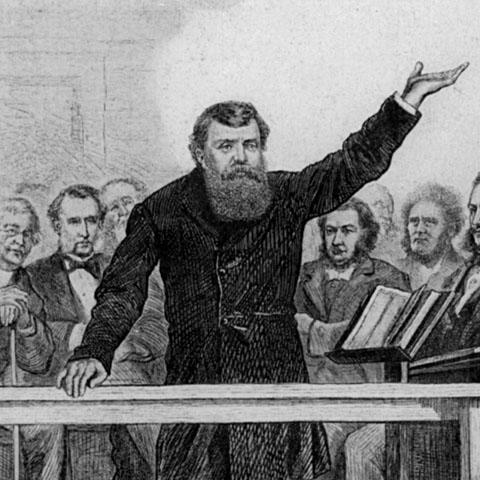 In the early 19th century, many so-called “mainstream Protestants”—Congregationalists, Presbyterians, Baptists, Methodists, and Anglicans—believed themselves to be responsible for the future of the fledgling United States. Although they founded interchurch agencies that worked toward social reform, some religious alliances eventually split as denominations took either “liberal” or “fundamentalist” stances.
In the early 19th century, many so-called “mainstream Protestants”—Congregationalists, Presbyterians, Baptists, Methodists, and Anglicans—believed themselves to be responsible for the future of the fledgling United States. Although they founded interchurch agencies that worked toward social reform, some religious alliances eventually split as denominations took either “liberal” or “fundamentalist” stances.
View full album
At the start of the 19th century, Christian churches were faced with the challenge of adjusting to an increasingly dynamic society as an industrial revolution took hold in the Northeast and settlers began to flood the western frontier. Census figures from 1790 give an indication of why Anglo-Protestants would play a decisive role in shaping American Christianity. Americans then numbered just under 4,000,000, of whom 1,000 to 3,000 were Jewish, 40,000 Catholic, and over 700,000 African-American, 99 percent of whom were enslaved. Of some 3,280,000 white Americans, roughly 2,900,000 were British and Protestant.
These Christians believed themselves to be responsible for the future of the republic. Shaped as they were by Protestantism, they also shared common instincts about many issues: the advantages of religious and political liberty; the moral challenges presented by the expansion of the nation’s frontier; the need for education; and the need to fashion persuasive forms of piety that could thrive in a voluntary society. Congregationalists, Presbyterians, Baptists, Methodists, and Anglicans (now called Episcopalians) soon transformed their long histories of difference and division into spirited but cooperative rivalries. They also forged numerous voluntary organizations as vehicles for moral reform: publishing and educational societies; charitable agencies; missionary networks; and temperance and anti-profanity groups. In many ways, this multitude of interchurch agencies formed a new de facto national religious establishment in place of an official “established” church. It was sometimes called the “Evangelical United Front” or “mainstream Protestantism.” Participants in this cooperative venture believed that they carried on the same sense of mission that inspired the first Protestant settlements in the seventeenth century and then the American Revolution in the eighteenth century. Some initiatives were led by clergy, but others allowed laypeople and women in particular to take Christian activism in new directions. Laypeople and women created new opportunities for activism in these parachurch organizations.
Also in the 19th century, the revivalist tradition inherited from the Great Awakening found new expression as evangelists like Charles Finney (1792-1875) refashioned revival techniques for use in the rapidly industrializing towns and cities. On the expanding frontier, rural camp meetings at places such as Cane Ridge, Kentucky, also became a familiar element of evangelicalism. As the frontier closed in the second half of the 19th century, other great revivalists like Phoebe Palmer (1807-1874) and Dwight Moody (1837-1899) moved into the booming cities of the Northeast and Midwest.
During the 19th century, new forms of Protestantism emerged in direct response to new ideas about the Bible, nature, and science. Some liberal Protestants, known as modernists (but often no less evangelical than revivalists) sought to adapt Christianity to the intellectual changes that ushered in modern society. Most notably, many modernists asserted the compatibility between the Bible and Darwinism. This liberal influence grew throughout the century to become a major force in American Protestantism, especially in its seminaries and denominational institutions. By the end of the century, a pronounced schism emerged between liberal and conservative camps over such issues as the authority of science, the infallibility of the Bible, and the role of Christianity in modern society. Here were the seeds of a “fundamentalist” and “liberal” split that shook most Protestant denominations after World War I, a split that in many ways solidified during the national drama of the Scopes Trial in 1925.